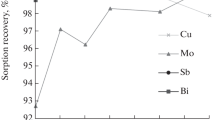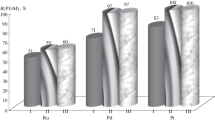Abstract
An approach to sorptive separation of Se(IV) from solutions on a new S,N-containing sorbent with subsequent determination of the analyte in the sorbent phase by the micro-X-ray fluorescence method is presented. The copolymethylenesulfide-N-alkyl-methylenamine (CMA) sorbent is synthesized using the “snake in the cage” procedure and has proven to be stable in acid solutions. Conditions for quantitative extraction of Se(IV) are determined: sorption in 5 M HCl or 0.05 M HNO3 solutions when heated to 60°C with the time of phase contact of 1 h. The residual selenium content in solution is determined by inductively coupled plasma mass spectrometry (ICP-MS) using the 82Se isotope. The absence of selenium losses is proved and the mechanism of sorption interaction under these specified conditions is proposed. The method of micro-X-ray fluorescence analysis (micro-XRF) with mapping reveals a uniform distribution of selenium over the sorbent surface. The possibility of determining selenium in the sorbent phase by micro-XRF is shown. When comparing the results with the results of calculations by the method of fundamental parameters, it is shown that, to obtain correct results of XRF determination of selenium in the sorbent phase, it is necessary to use standard samples of sorbates.



Similar content being viewed by others
REFERENCES
Adedara, I., Fabunmi, A., and Folashade, C., Neuroprotective mechanisms of selenium against arsenic-induced behavioral impairments in rats, Neurotoxicology, 2020, vol. 76, pp. 99–110. https://doi.org/10.1016/j.neuro.2019.10.009
Etteieb, S., Magdouli, S., Zolfaghari, M., and Brar, S., Monitoring and analysis of selenium as an emerging contaminant in mining industry: a critical review, Sci. Total Environ., 2020, vol. 698, art. ID 134339. https://doi.org/10.1016/j.scitotenv.2019.134339
Yücel, M.U., Başbuğan, Y., Uyar, A., et al., Use of an antiarrhythmic drug against acute selenium toxicity, J. Trace Elem. Med. Biol., 2020, vol. 59, art. ID 126471. https://doi.org/10.1016/j.jtemb.2020.126471
Carnrick, G.R., Manning, D.C., and Slavin, W., Determination of selenium in biological materials with platform furnace atomic-absorption spectroscopy and Zeeman background correction, Analyst, 1983, vol. 108, pp. 1297–1312. https://doi.org/10.1039/an9830801297
Bolea-Fernandez, E., Balcaen, L., Resano, M., and Vanhaecke, F., Interference-free determination of ultra-trace concentrations of arsenic and selenium using methyl fluoride as a reaction gas in ICP-MS/MS, Anal. Bioanal. Chem., 2015, vol. 407, pp. 919–929. https://doi.org/10.1007/s00216-014-8195-8
Pinho, J., Canário, J., Cesário, R., and Vale, C., A rapid acid digestion method with ICP-MS detection for the determination of selenium in dry sediments, Anal. Chim. Acta, 2005, vol. 551, pp. 207–212. https://doi.org/10.1016/j.aca.2005.07.002
Xiong, C., He, M., and Hu, B., On-line separation and preconcentration of inorganic arsenic and selenium species in natural water samples with CTAB-modified alkyl silica microcolumn and determination by inductively coupled plasma-optical emission spectrometry, Talanta, 2008, vol. 76, pp. 772–779. https://doi.org/10.1016/j.talanta.2008.04.031
Latorre, C.H., García, J.B., and Martín, S.G., Solid phase extraction for the speciation and preconcentration of inorganic selenium in water samples: a review, Anal. Chim. Acta, 2013, vol. 804, pp. 37–49. https://doi.org/10.1016/j.aca.2013.09.054
Sahina, F., Volkana, M., Howard, A., and Atamana, O., Selective pre-concentration of selenite from aqueous samples using mercaptosilica, Talanta, 2003, vol. 60, pp. 1003–1009. https://doi.org/10.1016/S0039-9140(03)00154-1
Serra, A.M., Estela, J.M., Coulomb, B., et al., Solid phase extraction—Multisyringe flow injection system for the spectrophotometric determination of selenium with 2,3-diaminonaphthalene, Talanta, 2010, vol. 81, pp. 572–577. https://doi.org/10.1016/j.talanta.2009.12.045
McCurdy, E.J., Lange, J.D., and Haygarth, P.M., The determination of selenium in sediments using hydride generation ICP-MS, Sci. Total Environ., 1993, vol. 135, pp. 131–136. https://doi.org/10.1016/0048-9697(93)90283-C
Kocot, K., Leardi, R., Walczak, B., and Sitko, R., Determination and speciation of trace and ultratrace selenium ions by energy-dispersive X-ray fluorescence spectrometry using graphene as solid adsorbent in dispersive micro-solid phase extraction, Talanta, 2015, vol. 134, pp. 360–365. https://doi.org/. 2014.11.036https://doi.org/10.1016/j.talanta
Dal’nova, O.A., Baranovskaya, V.B., Dal’nova, Yu.S., and Karpov, Yu.A., New complexing polymer aminothioether sorbents in the analytical control of recyclable metal-containing raw material of rare and noble metals, J. Anal. Chem., 2018, vol. 73, pp. 221–227. https://doi.org/10.1134/S1061934818030036
Filatova, D.G., Doronina, M.S., Dal’nova, O.A., et al., Determination of arsenic, selenium, and antimony by inductively coupled plasma mass spectrometry preceded by group sorption isolation, Inorg. Mater., 2014, vol. 50, no. 14, pp. 1417–1420. https://doi.org/10.1134/S0020168514140064
Funding
Utilization of the Tornado М4 plus micro-XRF spectrometer was supported by the program of development of Moscow State University. The investigation (in terms of selenium sorption and application of inductively coupled plasma mass spectrometry) was carried out at the expense of a grant of the Russian Science Foundation (project no. 20-13-00180).
Author information
Authors and Affiliations
Corresponding author
Additional information
Translated by Z. Smirnova
Rights and permissions
About this article
Cite this article
Filatova, D.G., Arkhipenko, A.A., Statkus, M.A. et al. Sorption of Se(IV) from Aqueous Solutions with Subsequent Determination by X-Ray Fluorescence Analysis. Inorg Mater 57, 1427–1430 (2021). https://doi.org/10.1134/S0020168521140053
Received:
Revised:
Accepted:
Published:
Issue Date:
DOI: https://doi.org/10.1134/S0020168521140053




